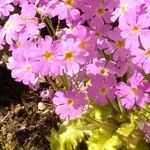Herbs perennial. Leaves forming a rosette; petiole 4--12(--18) cm, densely pilose; leaf blade ovate-oblong to oblong, 4--10 X (2--)3--7 cm, with grayish multicellular hairs, base cordate, rarely nearly rounded to truncate, margin crenate-lobulate, apex rounded; lobules crenulate-dentate. Scapes 12--25(--30) cm, pubescent; umbel solitary, 5--15-flowered; bracts linear-lanceolate, 4--10 mm. Pedicel 0.4--3 cm, sparsely pubescent or glabrescent. Flowers heterostylous. Calyx campanulate, 6--8 mm, enlarging to 1.5 cm in fruit, parted to middle or above; lobes ± spreading, lanceolate to ovate-lanceolate, pubescent or glabrous. Corolla rose to lilac-purple, rarely white; tube 0.9--1.3 cm; limb 1--2(--3) cm wide; lobes obovate, apex 2-cleft. Pin flowers: stamens slightly below middle of corolla tube; style ca. as long as tube. Thrum flowers: stamens near apex of corolla tube; style near middle of corolla tube. Capsule subglobose, ca. 1/2 as long as calyx. Fl. May, fr. Jun. 2n = 22, 24, 26, 29, 36.
More
A herb. It keeps growing from year to year. It grows 30 cm high and spreads 30-60 cm wide. It has a ring of leaves near the base. The leaves are heart shaped at the base and have coarse teeth. The flowers are white, pink or purple. They are in small heads.
Wet grassy places, especially by rivers, in lowland all over Japan. Wet areas in forests in northern China.
More
A temperate plant. In north China it grows in wet areas in forests. It suits hardiness zones 5-9.

